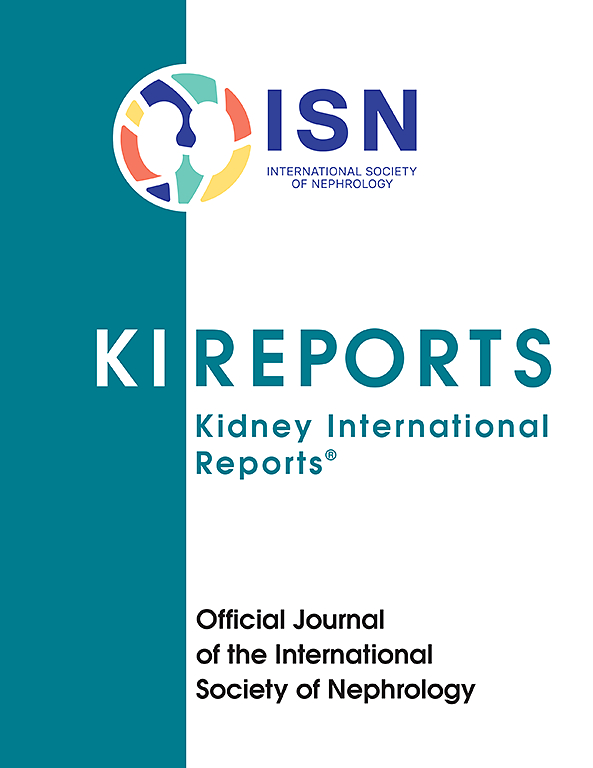Community-Acquired Acute Kidney Injury and Late Kidney Dysfunction in Survivors of COVID-19 Hospitalization
IF 5.7
2区 医学
Q1 UROLOGY & NEPHROLOGY
引用次数: 0
Abstract
Introduction
Data on the incidence and risk factors for renal long COVID are scarce. We aimed to investigate 2 acute kidney injury (AKI) phenotypes, namely community-acquired (CA; CA-AKI) and hospital-acquired (HA; HA-AKI), and the development of late kidney dysfunction in survivors of COVID-19 hospitalization.
Methods
This is a prospective cohort study of survivors of moderate-to-severe COVID-19 hospitalization in Brazil, from March to August 2020. The patients were assessed for up to 11 months after hospital discharge. Exposure was CA-AKI and HA-AKI. The main outcome was kidney dysfunction defined as incident low estimated glomerular filtration rate (eGFR; < 60 ml/min per 1.73 m2) and/or eGFR decline ≥ 25% from discharge at follow-up. An adjusted binary logistic regression analysis was run.
Results
A total of 655 survivors were evaluated (6.5 ± 1.9 follow-up months); 79% had AKI (35% CA and 43% HA); 14% used kidney replacement therapy (KRT). Late kidney dysfunction occurred in 28% of the patients (16% with incident low eGFR and 27% with eGFR decline ≥ 25%). CA-AKI, but not HA-AKI, was independently associated with late kidney dysfunction (adjusted odds ratio [aOR] = 7.3, 95% confidence interval (CI): 3.6–15.8 and aOR = 2.2, 95% CI: 0.9–4.8, respectively).
Conclusion
In conclusion, late kidney dysfunction affected 1 in 4 COVID-19 survivors. CA-AKI, but not HA-AKI, was an independent risk factor for late kidney dysfunction. These findings suggest that renal long COVID might be frequent and that a specific AKI phenotype (CA-AKI) may play a crucial role in its development. Our research highlights the need for CA-AKI prevention and for the long-term follow-up and care of patients affected by this AKI phenotype during COVID-19 infection.

COVID-19住院幸存者社区获得性急性肾损伤和晚期肾功能障碍
关于肾长型COVID的发病率和危险因素的数据很少。我们旨在研究2种急性肾损伤(AKI)表型,即社区获得性(CA; CA-AKI)和医院获得性(HA; HA-AKI),以及COVID-19住院幸存者晚期肾功能障碍的发展情况。方法:这是一项前瞻性队列研究,研究对象是2020年3月至8月在巴西接受COVID-19中重度住院治疗的幸存者。患者出院后11个月接受评估。暴露为CA-AKI和HA-AKI。主要结局是肾功能不全,定义为随访时估计肾小球滤过率低(eGFR; 60 ml/min / 1.73 m2)和/或出院时eGFR下降≥25%。采用调整后的二元logistic回归分析。结果共评估存活患者655例(6.5±1.9个月);79%有AKI (35% CA和43% HA);14%的患者使用肾脏替代疗法(KRT)。28%的患者发生晚期肾功能障碍(16%的患者发生eGFR低,27%的患者发生eGFR下降≥25%)。CA-AKI与晚期肾功能障碍独立相关,而HA-AKI与晚期肾功能障碍无关(调整优势比[aOR] = 7.3, 95%可信区间(CI): 3.6-15.8, aOR = 2.2, 95% CI: 0.9-4.8)。结论1 / 4的COVID-19幸存者存在晚期肾功能不全。CA-AKI是晚期肾功能不全的独立危险因素,HA-AKI则不是。这些发现表明肾长COVID可能是频繁发生的,并且特定的AKI表型(CA-AKI)可能在其发展中起关键作用。我们的研究强调了预防CA-AKI以及在COVID-19感染期间受这种AKI表型影响的患者的长期随访和护理的必要性。
本文章由计算机程序翻译,如有差异,请以英文原文为准。
求助全文
约1分钟内获得全文
求助全文
来源期刊

Kidney International Reports
Medicine-Nephrology
CiteScore
7.70
自引率
3.30%
发文量
1578
审稿时长
8 weeks
期刊介绍:
Kidney International Reports, an official journal of the International Society of Nephrology, is a peer-reviewed, open access journal devoted to the publication of leading research and developments related to kidney disease. With the primary aim of contributing to improved care of patients with kidney disease, the journal will publish original clinical and select translational articles and educational content related to the pathogenesis, evaluation and management of acute and chronic kidney disease, end stage renal disease (including transplantation), acid-base, fluid and electrolyte disturbances and hypertension. Of particular interest are submissions related to clinical trials, epidemiology, systematic reviews (including meta-analyses) and outcomes research. The journal will also provide a platform for wider dissemination of national and regional guidelines as well as consensus meeting reports.
 求助内容:
求助内容: 应助结果提醒方式:
应助结果提醒方式:


